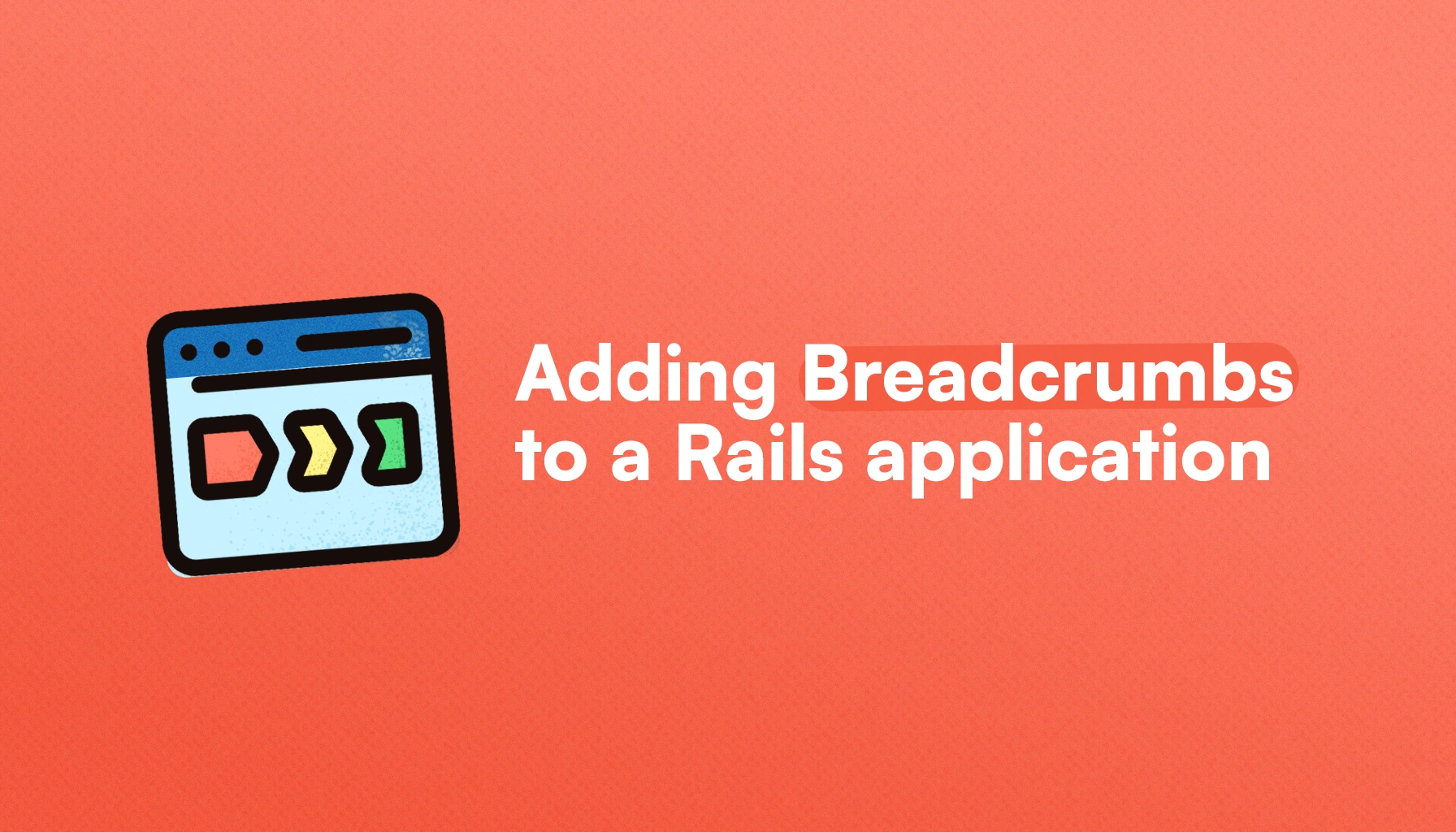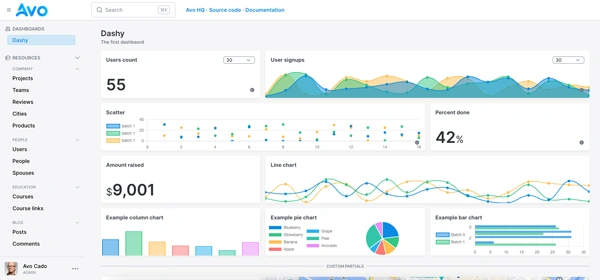
Helping users navigate through our site with ease helps them reach their desired destination thus improving their experience within our application.
Breadcrumbs play a crucial part in this: they give users a clear idea of where they are and provide them a path to reach
In this article, we will learn how to add breadcrumbs to a Rails app using the different types of breadcrumbs and way to add them in Rails applications.
Let's start by seeing why breadcrumbs are important. If you're already familiar with the jump to the adding breadcrumbs to Rails apps section
Why breadcrumbs?
The main reason to add breadcrumbs to any application is to improve user experience: they give a clear indication of where the user is on the page and the navigation paths that can be taken from there on.
They can help users reach a desired outcome faster without the need to know anything about our site beforehand while lowering the bounce rate at the same time.
Besides this user experience improvement, breadcrumbs show up in search results to give a quick glance of what a site contains

Search engines also love breadcrumbs because they help them figure out how our sites are structured and use them to improve the way they crawl our sites.
As an added bonus, good user experience in the form of engagement, lower bounce rates, and time spent on our site are ranking factors so, producing a good navigation experience can help get more organic traffic.
Types of breadcrumbs
There are roughly three types of breadcrumbs, and we should pick one depending on the needs of our users: the goal should be to make navigation faster and more efficient:
Hierarchical
These follow the site structure hierarchically with the home page, or other relevant sections, being the root.
They are the most common type of breadcrumbs and show users where they are within our site's structure and give them the ability to access the most relevant parts of our site in a couple of clicks.
For example: Products -> Electronics -> Smart watches -> Apple Watch.
Sometimes hierarchical breadcrumbs form a parent-children relation where every breadcrumb, except the root, is a descendant of the breadcrumb to the left.

An example from inside Avo's Rails Admin panel:

Filter or attribute-based
These are common for collection pages where filters can be applied. They are usually complementary to hierarchical breadcrumbs, and they allow us to quickly see the filters we applied to a given collection.
The particular thing about attribute-based breadcrumbs is that they might not generate new URLs or even produce an actual visit, they are just a way to make visually clear the steps the user took to reach a given point, in this case: the collection that's actually on the page.
Here's an example where a site is using a mix of hierarchical and attribute-based breadcrumbs:

On the top of the page we can see the hierarchy, and below the filtering options we can see the applied filters with Women / Accessories and Sunglasses applied by default and the applied filters displayed right to the side of them.
History-based
These are also complementary with hierarchical breadcrumbs. They generally have one or more links to track the previous pages we visited irrespective of their hierarchy.
An example from an e-commerce site:

This is a listing for a specific guitar that was accessed from a search query for “Gibson SG”. Clicking on “Volver al listado” (Back to the listing) will take us back to the search page that responded to our query.
This type of breadcrumbs is useful for big sites where users have multiple ways to reach to the same page.
Now that we saw the different types of breadcrumbs let's see what we will build.
What we will build
For this particular tutorial we will build a breadcrumbs component with the following requirements:
- We should be able to generate a list of breadcrumbs inside controllers.
- A particular breadcrumb can render a link or text depending on whether the argument is a path, URL, or plain text.
- A breadcrumb can be represented with text exclusively or next to an icon like a “home” icon for the root path.
- The breadcrumb component should produce the adequate schema markup.
- The breadcrumb component should accept a special type of path or URL to produce a history/hierarchical type of breadcrumb.
- In case it's required, we should be able to pass
turbo: falseto individual links or to theBreadcrumbsComponentif we want to disable Turbo for every link.
Now that we know the requirements, let's continue with the setup
Application setup
For this application, we will use bukclub the book directory application we used for previous articles like MCP Servers in Rails or Rails social login.
However, the app itself is not that important, you can follow along with an existing app or start from scratch.
We will use the ViewComponent gem to render our breadcrumbs, so let's install it:
bundle add view_component && bundle install
The Rails helpers for Lucide Icons:
bundle add lucide-rails && bundle install
Then, let's generate a Breadcrumbs component:
bin/rails generate view_component:component Breadcrumbs items
Now let's focus on adding the breadcrumb to our app:
Adding breadcrumbs
Before anything, let's define the static breadcrumbs component:
Breadcrumbs component
We know that the component will receive a list of items. For now, let's render our component and default the items params to contain an empty array:
<%= render BreadcrumbsComponent.new() %>
Currently, the component class looks like this:
class BreadcrumbsComponent < ViewComponent::Base
def initialize(items: [])
@items = items
end
end
Then, let's render the static markup. Semantically, breadcrumbs are a navigation element that contains an ordered list of items:
# app/components/breadcrumbs_component.html.erb
<nav aria-label="Breadcrumb navigation">
<ol class="flex flex-wrap items-center space-x-2 text-sm">
<li>
<a href="/" class="flex items-center space-x-2 text-gray-500 dark:text-gray-400 hover:text-emerald-600 dark:hover:text-emerald-500">
<%= helpers.lucide_icon('home', class: "h-5 w-5 text-slate-700 dark:text-slate-300") %>
<span class="text-slate-700 dark:text-slate-300 text-base">Home</span>
</a>
</li>
<%= helpers.lucide_icon('chevron-right', class: "h-5 w-5 text-slate-700 dark:text-slate-300") %>
<li>
<a href="/" class="text-gray-500 dark:text-gray-400 hover:text-emerald-600 dark:hover:text-emerald-500">
<span class="text-slate-700 dark:text-slate-300 text-base">Books</span>
</a>
</li>
<%= helpers.lucide_icon('chevron-right', class: "h-5 w-5 text-slate-700 dark:text-slate-300") %>
<li>
<span class="text-slate-700 dark:text-slate-300 text-base">The Catcher in the Rye</span>
</li>
</ol>
</nav>
Which produces the following result, including dark mode:

With the markup in place, let's start writing the tests and adding the code:
Tests
Because we defined that breadcrumbs can be a link or text, have an icon or not let's create an empty Breacrumb class and then write our first test:
# app/models/breadcrumb.rb
class Breadcrumb
end
Let's add tests for the model:
require "test_helper"
class BreadcrumbTest < ActiveSupport::TestCase
test "it know if it is a link" do
breadcrumb = Breadcrumb.new(
name: "Home",
path: "/",
)
assert breadcrumb.link?
end
test "it knows if it has an associated icon" do
breadcrumb = Breadcrumb.new(
name: "Home",
path: "/",
icon: "home",
)
assert breadcrumb.has_icon?
end
end
We then add the model code to satisfy the tests:
class Breadcrumb
attr_reader :text, :path, :icon, :turbo
def initialize(text: nil, path: nil, icon: nil, turbo: true)
@text = text
@path = path
@icon = icon
@turbo = turbo
end
def link?
path.present?
end
def has_icon?
icon.present?
end
end
Now, before going back to the component code to add the appropriate conditionals, let's add a hardcoded list of breadcrumbs to work with:
<% items = [Breadcrumb.new(text: "Home", path: root_path, icon: "home"), Breadcrumb.new(text: "Books", path: books_path), Breadcrumb.new(text: "The Catcher in the Rye")] %>
<%= render BreadcrumbsComponent.new(items: items) %>
Which should produce the same output as before:

Now that we can produce the breadcrumbs from hardcoded values, let's add code to produce the breadcrumb list from controller actions.
To achieve this, we can add a couple of methods to our ApplicationController that we can call from any other controller.
class ApplicationController < ActionController::Base
helper_method :breadcrumbs
private
def breadcrumbs
@breadcrumbs ||= []
end
def add_breadcrumb(text:, path: nil, icon: nil, turbo: false)
breadcrumbs << Breadcrumb.new(text: text, path: path, icon: icon, turbo: turbo)
end
end
The breadcrumbs method declares and memoizes the @breadcrumbs instance variable which returns an empty array by default, and the add_breadcrumb, which is the method we will use across our controllers is used to add instances of Breadcrumb to the array.
If we want to abstract the code away from the ApplicationController we can create a concern:
# app/controllers/concerns/breadcrumbs.rb
module Breadcrumbs
extend ActiveSupport::Concern
included do
helper_method :breadcrumbs
end
def add_breadcrumb(text, path: nil, icon: nil)
breadcrumbs << Breadcrumb.new(text: text, path: path, icon: icon)
end
def breadcrumbs
@breadcrumbs ||= []
end
end
class ApplicationController < ActionController::Base
include Breadcrumbs
end
With this in place, we can produce our desired result by
class BooksController < ApplicationController
def show
@book = Book.find(params[:id])
add_breadcrumb("Home", path: root_path)
add_breadcrumb("Books", path: books_path)
add_breadcrumb(@book.title)
end
end
Now, adding the adequate conditionals, we can produce the desired breadcrumbs:
<nav aria-label="Breadcrumb navigation" data-turbo="<%= turbo %>">
<ol class="flex flex-wrap items-center space-x-2 text-sm">
<% items.each_with_index do |breadcrumb, index| %>
<% if breadcrumb.path.present? %>
<li>
<a href="<%= breadcrumb.path %>" class="flex items-center space-x-2 text-gray-500 dark:text-gray-400 hover:text-emerald-600 dark:hover:text-emerald-500" data-turbo="<%= turbo %>">
<%= helpers.lucide_icon(breadcrumb.icon, class: "h-5 w-5 text-slate-700 dark:text-slate-300") if breadcrumb.has_icon? %>
<span class="text-slate-700 dark:text-slate-300 text-base leading-none"><%= breadcrumb.text %></span>
</a>
</li>
<% else %>
<li>
<span class="text-slate-700 dark:text-slate-300 text-base leading-none"><%= breadcrumb.text %></span>
</li>
<% end %>
<% if index < items.length - 1 %>
<%= helpers.lucide_icon('chevron-right', class: "h-5 w-5 text-slate-700 dark:text-slate-300") %>
<% end %>
<% end %>
</ol>
</nav>
Which produces the same as we had before:

Now that we know how to generate breadcrumbs, let's add the schema markup to improve our Rails SEO results:
Schema Markup
Adding schema markup to our breadcrumbs component can help search engines better understand our site's navigation because we provide information about the breadcrumb entity in a structured manner.
We could use structured data with the ld+json script, but we can define it in the component itself because everything we need is self-contained in a single file.
Following Google's Guidelines, and we end up with this:
<nav aria-label="Breadcrumb navigation">
<ol class="flex flex-wrap items-center space-x-2 text-sm" itemscope itemtype="https://schema.org/BreadcrumbList">
<% items.each_with_index do |item, index| %>
<li itemprop="itemListElement" itemscope itemtype="https://schema.org/ListItem">
<% if item.links_to_root? %>
<a href="/" itemprop="item" class="text-gray-500 dark:text-gray-400 hover:text-emerald-600 dark:hover:text-emerald-500">
<%= helpers.lucide_icon('home', class: "h-5 w-5 text-slate-700 dark:text-slate-300") %>
<span itemprop="name">Home</span>
</a>
<% else %>
<a href="<%= item.url %>" itemprop="item" class="text-gray-500 dark:text-gray-400 hover:text-emerald-600 dark:hover:text-emerald-500">
<span itemprop="name" class="text-slate-700 dark:text-slate-300 text-base"><%= item.text %></span>
</a>
<% end %>
<meta itemprop="position" content="<%= index + 1 %>">
</li>
<% if index < items.length - 1 %>
<%= helpers.lucide_icon('chevron-right', class: "h-5 w-5 text-slate-700 dark:text-slate-300", "aria-hidden": "true") %>
<% end %>
<% end %>
</ol>
</nav>
We define the itemscope to be the BreadcrumbList type, and then, for each one of the items inside the breadcrumb list we define a ListItem with its own itemscope and itemtype.
Each list item contains the structured data properties that search engines expect: the item property points to the URL, the name property contains the display text, and the position property indicates the item's sequential order in the breadcrumb trail.`
With this in place, we can now use our BreadcrumbsComponent anywhere in our application.
Summary
Adding breadcrumbs to a Rails application is an easy way to improve user experience and SEO at the same time.
Letting users know where they stand and how they can reach their desired target is a sure way to improve our bounce rate, increase the average visit duration while improving our chances with search engines.
We added breadcrumbs using ViewComponent, a custom model, and some shared controller code that let us add breadcrumbs from any controller action.
Moreover, we added schema markup to our breadcrumbs to make sure that they contain appropriate metadata to appear in search results.

